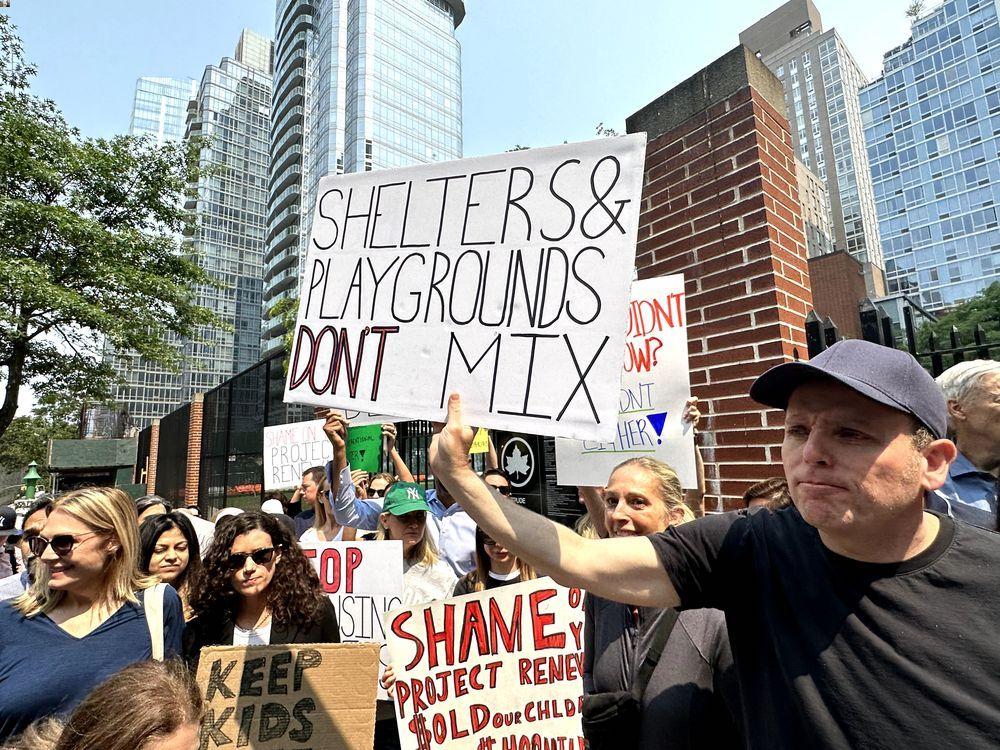This is an op-ed written by Rachel Nazarian, Heather Groeger & The Friends of Ederle Playground Community Group

A September 2023 protest at the site of the women’s shelter being built at West 59th Street. Photo by Bobby Panza.
For four decades New York City has maintained its “right to shelter” mandate, helping to establish one of the lowest rates of unsheltered homelessness in the nation. However, despite this fact, New York City simultaneously maintains one of the highest populations of homelessness nationwide. As it stands, we are struggling to support over 100,000 individuals, and with a record number of asylum seekers arriving in 2023, the city’s promise to shelter all of those in need is becoming nearly impossible to keep.
Advertisement
There is no denying the demand for immediate action. Vulnerable populations should not have to resort to sleeping or living on the streets. Existing buildings, hotels, and available spaces are well-suited for providing temporary support. However, our lack of long-term solutions seems to be perpetuating a growing problem, rather than empowering individuals with a place to turn after their shelter stay.
In January of 2022 Mayor Eric Adams acknowledged the housing crisis here in New York City by appointing an Affordable Housing Leadership team. Together these individuals are set to spearhead the administration’s affordable housing strategy by supporting a variety of measures including upzoning areas with robust infrastructure and around major transit hubs, creating a new housing supply around the five boroughs, legalizing basement apartment dwellings, and converting underused hotels and office buildings into affordable housing.
Ironically, the exact opposite seems to be happening on the Upper West Side. In fact, at this time, New York City nonprofit, Project Renewal, is in the process of constructing a $500 million shelter from the ground up on West 59th street. Originally approved under the DeBlasio administration, this women’s shelter is set to temporarily house 200 women, many of whom are suffering from chemical addiction and/or mental illness. In addition, the facility will also include a street-level health clinic that provides suboxone to the general public in walking distance from a popular community park.
While the goal of this project may be well-meaning, it will not significantly move the needle in our battle against homelessness. This is because the solution New Yorkers are calling for (which has been acknowledged by the Department of Housing Preservation and Development) is one that offers permanent support. In a financial climate where housing affordability has worsened and government cutbacks continue to target low-income communities, we need ways to link those in danger of long-term homelessness with subsidized housing. Otherwise, shelter stays become cyclical for the vast majority of homeless New Yorkers. In fact, both research and experience have shown that investments in permanent affordable housing are extraordinarily effective in reducing homelessness.
Advertisement
With support from the State and City of New York as well as passionate elected officials, the Brooklyn Public Library and Fifth Avenue Committee recently completed a first-of-its-kind, mixed-use development project that couples 100% affordable housing with a 20,000 square foot public library. In addition to doubling the size of the previous branch with modern amenities and community spaces, the Sunset Park Library and Apartments project offers 49 units for low- and moderate-income residents, as well as units designated to receive Section 8 subsidies. The successful completion of this project has not only provided a tangible response to the critical housing needs of the community, but also acts as a model for future developments throughout the city.
Calls for permanent, affordable housing exist in all five boroughs. However, unlike in Brooklyn where community voices are finally being heard, Project Renewal is turning a blind eye to mounting disapproval. For that reason, the Friends of the Ederle Playground, a local Upper West Side community group, is publicly requesting that Project Renewal’s development be used instead to create apartment units for families and individuals battling homelessness.
Will the Department of Housing Preservation and Development stay true to its word and consider offering the city a more permanent solution? Here’s to hoping.



There is a reason UWS real estate has not appreciated in the past 10 years. Consistently underperforming gains in other areas of the city downtown/Brooklyn etc…. The neighborhood has vastly more shelters and supportive housing than other neighborhoods. While noble in cause, if not done within reason it can have a crowding out effect. Progressives clearly don’t care about this. Preferring the timely campaign donations they get from the private companies who operate and run the shelters with unbridled city funding. Time for Gale Brewer to do her job and stop adding to the neighborhood. The UES has 1/10th the supportive housing/shelters the UWS has. Time for them to share the burden.
NYC really has to look to major thriving first world metropolis, compare and apply in order to really find the “better/best” way. The fact that the “free market” allows real estate to charge based on location, views, ‘what the market says today’, but renters and owners cannot demand to pay “alla free market” to walk down metal caged sidewalks (aka scaffolding), is absurd. Like now we have to charge 5k because the city raised the taxes and we have to pay for building work, etc, but then can I ask the city to show how much of the tax dollars for the neighborhood are covering these costs of the filth outside of the buildings, and since I have to live under metal and construction sounds (not to mention those damn helicopters constantly making the background over the parks like a freaking war zone) then I’ll deduct from the 5k if Im forced to live uncomfortably in a city who offers general starting salaries before taxes 40k -60k after taxes, cost of living, cost of processed food, healthcare ends up being closer to 28k- 48k. Truly shameful.
As NYC is supposedly a melting pot, my husband and I have the privilege to pay taxes in two countries (even though I never really see where my u.s./nyc taxes go) and new property reform laws in Milano – who’s building’s are much older – cannot have scaffolding (aka metal cages) for longer than a few months, and the law requires that the state (country) covers the costs from tax dollars, hence there are no incentives to keep them up for years. Instead the way it’s set up between the scaffolding companies getting paid monthly, and construction based on project deadline, has a lot to do with why the building in front of me has had metal cages (aka scaffolding) and animal urine smells for over 10 years and the people in the building get their rents raised, is just insane to me, more 3rd worldly really.
This neighborhood could absolutely do to follow this BK example, and go beyond as practice brings innovation. On top of that where are all the restaurants, cafe’s that don’t serve paper cups lined with plastic, small and local cafes. So many empty store fronts and banks and then the few restaurants that we do have close early. Why don’t building owners partner with cultural institutions and bring life back to this neighborhood (tbc not shops, not soho or Le Marais now in Paris, but culture).
At the end of my block we have a shelter for people who had no choice but to come here in hopes of moving on or one day going back where their degrees equate them a quality life. Why is it that the u.s. speaks only one language, is the youngest first world, and refuses to recognise global education — weirdly eery — so we’ve got delivery bikes everywhere, instead of new educators, engineers, nurses, union workers. Instead we’ve turned educated people into bottom feeders.
I am much more bothered by the scaffolding (aka metal cages) that deface the buildings and well make me question everyday how the hell do nyers pay whatever they’re told for dark depressing sidewalks, beautiful facades covered in wood and metal, smells from animals, etc, the mental health repercussions from the metal, the people pushing on the sidewalks, I mean we definitely don’t need more construction (its a construction sound bite all day everyday its just so awful), more toxic fumes in the air, more pollution on the ground. We need salaries to equate living costs (literally no wiser first world metropolis believes in a ‘good debt system’) and to have a right to a quality life, as many other big first world cities, this would give people the mental wellbeing to believe in opportunity. Could a neighborhood start a cultural refresh on how we do real estate, policy, infrastructure and really bring the beauty of the neighborhood back?